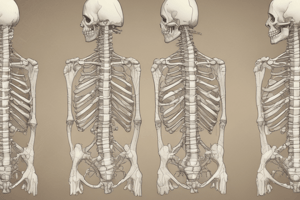Podcast
Questions and Answers
How many vertebrae are there in the human spine?
How many vertebrae are there in the human spine?
- 25
- 30
- 33 (correct)
- 35
What is unique about the L5 vertebra?
What is unique about the L5 vertebra?
- It does not have a lumbosacral angle
- It has a similar structure to the other lumbar vertebrae
- It has the largest body and transverse processes of all vertebrae (correct)
- It has the smallest body and transverse processes
What is the primary force acting on the spine?
What is the primary force acting on the spine?
- Intraabdominal pressure
- Axial force (correct)
- Tension in the spinal ligaments
- Tension in the surrounding muscles
What is the result of the total body center of gravity being anterior to the spinal column?
What is the result of the total body center of gravity being anterior to the spinal column?
What counteracts the torque in the upright position?
What counteracts the torque in the upright position?
What is the definition of torque?
What is the definition of torque?
What percentage of Americans experience low back pain at some point in their lives?
What percentage of Americans experience low back pain at some point in their lives?
What is the primary cause of low back pain?
What is the primary cause of low back pain?
Flashcards are hidden until you start studying
Study Notes
Structure of the Lumbar Region
- The lumbar spine consists of 5 vertebrae (L1-L5) and 23 intervertebral disks.
- The first four lumbar vertebrae (L1-L4) have a similar structure.
- The fifth lumbar vertebra (L5) has a unique structure adapted for articulation with the sacrum.
Characteristics of the L5 Vertebra
- L5 has the largest body and transverse processes of all vertebrae.
- The anterior aspect of the L5 body is taller than its posterior aspect, creating the lumbosacral angle.
Forces Acting on the Spine
- Forces acting on the spine include body weight, tension in the spinal ligaments, tension in the surrounding muscles, and intra-abdominal pressure.
- The primary form of loading on the spine is axial.
Upright Position and Spinal Compression
- In an upright position, the spine is subjected to constant forward bending moment and torque.
- Spinal compression results from body weight and weight held by arms and hands.
- The total body center of gravity is anterior to the spinal column.
Torque and Counteraction
- Torque is defined as the rotary effect of a force about an axis of rotation, measured as the product of the force and the perpendicular distance between the force's line of action and the axis.
- To maintain an upright position, torque is counteracted by tension in the back extensor muscles.
Low Back Pain
- 75%-80% of Americans experience low back pain at some point in their lives, making it the second most common cause of absence in the workplace after the common cold.
- Mechanical stress and psychosocial factors contribute to low back pain.
Studying That Suits You
Use AI to generate personalized quizzes and flashcards to suit your learning preferences.




